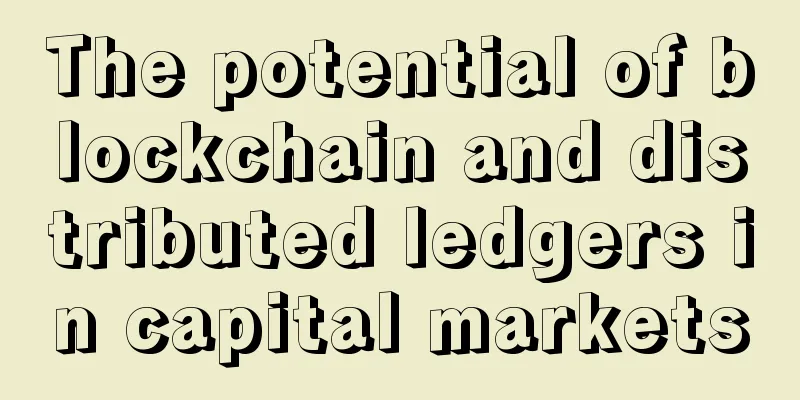The potential of blockchain and distributed ledgers in capital markets

|
Blockchain technology is being studied by many industry insiders to rebuild and subvert the way financial markets operate. It can be said that the most important blockchain technology applied in the capital market is distributed ledger technology (DLT), which can remove extremely inefficient and costly parts of the current market infrastructure. However, despite the potential for DLT to disrupt current markets, challenges remain, many of which are more company-related than technology-driven. We can draw on the major challenges encountered in market infrastructure over the past 30 years to predict the problems that DLT may encounter in the future. How much of our work is recorded on paper? Thirty years ago, the stock market was largely recorded through certificates and ledgers, and it took five days to settle transactions, mainly because it took time for these texts to be transmitted between the trading parties. Now that these processes have been digitized, transactions can be carried out through digital processes. To a certain extent, the clearing and settlement processes will largely borrow from the previous text processes. This will cause three inefficiencies: reconciling the trading records of each trading party; centralized suppliers need to manage risks and strengthen communication; there is a 2-3 day delay between the trading day and the settlement day. Can distributed ledger technology solve these inefficiencies? Fundamentally, the reasons for the current high costs of market infrastructure can be divided into three categories: transaction costs, costs of maintaining capital, and costs of insuring risk. The costs required to be insured include: counterparty risk, principal risk, etc. These costs are very expensive. They also include the costs of requiring the intermediary to manage the risk. Reducing the settlement time, or even achieving instant settlement, can effectively reduce the risk. Distributed ledger technology is considered a feasible technology to reduce the settlement time. Transaction costs include the cost of recording ownership by depository institutions, intermediaries and multiple back-office departments all linked by complex electronic messaging protocols, but each protocol has its own version. Fees paid to trusted third parties are reduced, mediation costs are reduced, and therefore transaction costs are reduced. The question is whether and how much DLT can reduce these costs depends on changes in business rules rather than the introduction of technology. DLT can only achieve the corresponding effect if it completely transforms the market in the four scenarios proposed in this paper. What are the elements of success? In order for a distributed ledger to help reduce costs, it must meet all the requirements of capital markets needs:
Otherwise, there is a risk of reducing the efficiency of the current market. In some cases, especially where there is a high level of regulation and mature market infrastructure, distributed ledger technology is more likely to form a new architecture rather than completely replace the current institutions. We envision four possible scenarios for the introduction of distributed ledger technology into the capital market clearing and settlement process, with different impacts on the operations of various capital market participants. 1. Technological substitution This represents limited disruption to current market operators by introducing blockchain technology. From a technical perspective, this is the easiest scenario to achieve, as it is the fastest to implement if there are any changes to the market structure. From a business perspective, this provides the least cost savings to the market, and can be seen as a stepping stone for further evolution. 2. Scalable ledger Technology can be extended to provide a scalable ‘smart ledger’, which can be achieved through collaboration between industry participants. Creating a fully open and collaborative platform for major capital market infrastructure while meeting all applicable regulations is a huge challenge and cannot be achieved in the short term. 3. New global C&S infrastructure A global alliance of intermediaries, banks and C&S providers working together on the next generation distributed ledger C&S platform is already possible through the R3 blockchain alliance. However, such a scenario will take many years to achieve and can only be achieved step by step. 4. Uber ’s financial model Distributed ledger technology is a truly global peer-to-peer network that can replace the traditional capital markets system. Several technology platforms that provide this service already exist in some form or are still under development, but it is not clear whether these technology platforms will challenge the traditional market infrastructure. As we have seen with other peer-to-peer technologies such as Bitcoin and Uber, a certain degree of interoperability with applicable regulatory frameworks is key to mainstream acceptance. |
<<: Blockchain: It will be easy to prove that "your mother is your mother" in the future
>>: Ethereum hard fork proposal released, leaving only 15 days for the community
Recommend
Is it good for a man to have three white eyes?
When we communicate with others, we should always...
Why Bitcoin Did Not Show Safe-haven Properties After Falling Below $35,000
On February 24, the market showed that BTC fell b...
Is it good or bad to have a garlic nose? It is a typical businessman's appearance!
What does a bulbous nose look like? A garlic nose...
Is it true that if the brows are low and the bridge of the nose is blue, this person will be doomed to disaster?
The most important thing in life is success. Ever...
What does it mean for a man to have a mole on his forehead? He will have a successful career and a bright future!
What does it mean for a man to have a mole on his...
CubeUpload, a long-established British brand, is a stable and reliable online image hosting platform with unlimited capacity and free image storage.
As a long-established free image hosting service,...
The first blockchain and real estate “meet-up” in Washington
Baozou Comment : Cross-industry exchanges and mee...
Is it good for a man with narrow eyes to have a good face? Analysis of the face of a man with narrow eyes
The peach blossom eyes that people often talk abo...
Mining machine computing power market quarterly report (2020.11-2021.1)
summary: 1. From November 1, 2020 to January 20, ...
Will a woman with a broken palm definitely bring bad luck to her husband?
As the saying goes, "A man with a broken pal...
What are the characteristics of the entrance of nasolabial folds on a woman’s face? Analysis of the nasolabial folds on a woman’s face!
As we age, more and more wrinkles appear on our f...
The U.S. Department of Defense research agency awarded two companies $1.8 million contracts to verify a data integrity monitoring system based on blockchain technology
The U.S. Defense Advanced Research Projects Agenc...
2019 Global Digital Mining Summit: Wu Jihan announces Bitmain’s latest initiatives
"We are currently in a short-term correction...
Coin Zone Trends: Bitcoin Price Trends Based on Big Data This Week (2016-11-03)
Strong buying by newcomers drives the price of co...
Bitcoin is weak in upward movement, Ethereum falls below $2,400
In the past 24 hours, the crypto market has gener...









